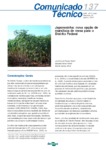Please use this identifier to cite or link to this item:
http://www.infoteca.cnptia.embrapa.br/infoteca/handle/doc/569002Full metadata record
| DC Field | Value | Language |
|---|---|---|
| dc.contributor.author | FIALHO, J. de F. | pt_BR |
| dc.contributor.author | VIEIRA, E. A. | pt_BR |
| dc.contributor.author | SILVA, M. S. | pt_BR |
| dc.date.accessioned | 2011-04-10T11:11:11Z | pt_BR |
| dc.date.available | 2011-04-10T11:11:11Z | pt_BR |
| dc.date.created | 2008-04-18 | pt_BR |
| dc.date.issued | 2007 | pt_BR |
| dc.identifier.citation | Planaltina, DF: Embrapa Cerrados, 2007. | pt_BR |
| dc.identifier.uri | http://www.infoteca.cnptia.embrapa.br/infoteca/handle/doc/569002 | pt_BR |
| dc.description | ABSTRACT: The cassava market within Distrito Federal (DF) presents potencial for expansion, for that reason, it is fundamental that the propagative material for planting (stem cuttings) presents genetic traits that confer high productivity to the crop, resistance against the main diseases and plagues and culinary qualities that fulfill the demands of the consumer market. In order to select varieties which combine the before mentioned interesting caracteristics for the producers and consumers of DF, we carried out experiments to evaluate table cassava type varieties at Núcleo Rural Jardim, DF (year 1999/2000), at an experimental area of Embrapa Cerrados located in the Municipy of Planaltina, DF (year 1999/2000), at Núcleo Rural Ponte Alta, DF (year 2002/2003) and at Brazlândia, DF (year 2003/2004). Among the evaluated varieties, if the parameters productivity, time necessary for cooking and colour of the pulp (which, in the case of DF, must be cream-colour or yellow due to market demands) are collectively considered, the variety Japonesinha / IAC 576-70 / BGMC 753 stands out as it combines high productivity of roots, moderate resistance to bacterial blight, good culinary quality (time necessary for cooking inferior to thirty minutes) and pulp of cream colour. Conclusively, this variety can be recommended to be cultivated at DF. | pt_BR |
| dc.language.iso | por | pt_BR |
| dc.relation.ispartofseries | (Embrapa Cerrados. Comunicado Técnico, 137). | pt_BR |
| dc.rights | openAccess | pt_BR |
| dc.subject | Maninhot esculenta | pt_BR |
| dc.subject | Cultura anual | pt_BR |
| dc.subject | Cozimento | pt_BR |
| dc.subject | Cooking time | pt_BR |
| dc.title | Japonesinha: nova opção de mandioca de mesa para o Distrito Federal. | pt_BR |
| dc.type | Folhetos | pt_BR |
| dc.date.updated | 2013-02-18T11:11:11Z | pt_BR |
| dc.subject.thesagro | Cerrado | pt_BR |
| dc.subject.thesagro | Cocção | pt_BR |
| dc.subject.thesagro | Culinária | pt_BR |
| dc.subject.thesagro | Mandioca | pt_BR |
| dc.subject.thesagro | Rendimento | pt_BR |
| dc.subject.thesagro | Variedade | pt_BR |
| dc.subject.nalthesaurus | annuals | pt_BR |
| dc.subject.nalthesaurus | cassava | pt_BR |
| dc.subject.nalthesaurus | foods | pt_BR |
| dc.subject.nalthesaurus | varieties | pt_BR |
| dc.subject.nalthesaurus | yields | pt_BR |
| dc.format.extent2 | 4 p. | pt_BR |
| riaa.ainfo.id | 569002 | pt_BR |
| riaa.ainfo.lastupdate | 2013-02-18 | pt_BR |
| dc.contributor.institution | Josefino de Freitas Fialho, CPAC; Eduardo Alano Vieira, CPAC; Marília Santos Silva, CPAC. | pt_BR |
| Appears in Collections: | Comunicado Técnico (CPAC)  | |
Files in This Item:
| File | Description | Size | Format | |
|---|---|---|---|---|
| comtec137.pdf | 58.37 kB | Adobe PDF |  View/Open |









